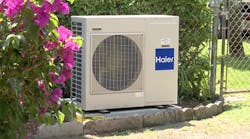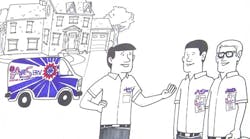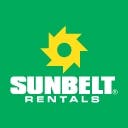Now that the COVID-19 pandemic seems to be in the rearview mirror, building owners, managers, engineers, and HVAC contractors have started thinking about how to prepare buildings for future infectious disease emergencies. To that end, the American Society of Heating, Refrigerating and Air-Conditioning Engineers has developed Standard 241, a new airborne infection risk mitigation standard for buildings.
ASHRAE Standard 241, Control of Infectious Aerosols, “establishes minimum requirements to reduce the risk of disease transmission by exposure to infectious aerosols in new buildings, existing buildings, and major renovations.” The new standard builds on ASHRAE Standard 62.1-2022, Ventilation and Acceptable Indoor Air Quality, which defines indoor ventilation and air quality requirements during normal conditions.
The new standard is geared toward establishing a plan for building owners to activate when the risk of disease transmission is high, a status ASHRAE dubs “Infection Risk Management Mode.” It may take a while for Standard 241 to be adopted into building codes. However, some building owners may choose to adopt it as a way to better market their facilities, whether it’s a company seeking to reassure workers or a hotel wanting to give guests peace of mind.
Additionally, the smoke events produced by Canadian wildfire smoke drifting to the U.S. Midwest and East Coast could spur building owners to implement a plan.
Building owners can save money by working with a reliable rental partner that can help identify the right equipment and secure it when the time comes. Let’s review key aspects of the new standard and how to set your facility up for success.
Equivalent Clean Airflow Rate Gives Building Owners Options
ASHRAE Standards 62.1 and 62.2 specify outdoor airflow rates. The recommendations ASHRAE made in 2020 during the height of the pandemic also emphasized bringing in more outside air. But adding outside air increases demand on HVAC systems to more than they’re designed to handle, which meant adding supplemental heating or cooling to keep occupants comfortable.
Standard 241 establishes an Equivalent Clean Airflow Rate that gives facilities managers the option to use a combination of filtration and air-cleaning technologies to achieve the standard.
Although increasing filtration is critical, some older HVAC systems don’t have room for larger, thicker filters. This means they can’t be installed in the permanent system. Temporary solutions, such as air scrubbers, portable air disinfection machines, and air purifiers, will enable you to use filters with higher MERV ratings if overhauling your permanent system is cost-prohibitive.
Sunbelt Rentals can design and implement a HEPA filtration strategy for a room or an entire building. Air scrubbers take in air and run it through a prefilter, HEPA filter, and postfilter to remove 99.97% of contaminants. Then, the system pushes clean air into the space where it’s needed.
Even if your existing system uses filters with a MERV 8 rating, upgrading to MERV 13 or 14 will cause airflow through the system to drop. A temporary, supplemental HVAC unit can provide the additional air needed. Furthermore, all Sunbelt Rentals air-conditioning and air handling units can be equipped with UV-C germicidal light kits.
Standard Calls for Creating a Plan, Outlines Procedures for Commissioning System
Standard 241 includes planning and assessment requirements that ladder up to a building readiness plan. This includes procedures for commissioning systems to determine their installed performance.
Partnering with a rental provider can not only help you choose the right equipment but also test it to ensure your building meets the equivalent clean airflow needed to ensure your facility is prepared. In addition to protecting against airborne infectious diseases, plans that use filtration can also be activated during smoke events such as those that darkened the skies of the eastern United States in spring 2023.
Contact us to learn more about our indoor air quality and ventilation expertise.
SPONSORED BY:









